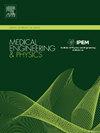Quantitative Capillary Refill Time with image-based finger force estimation
IF 1.7
4区 医学
Q3 ENGINEERING, BIOMEDICAL
引用次数: 0
Abstract
Skin color observation provides a simple and non-invasive method to estimate the health status of patients. Capillary Refill Time (CRT) is widely used as an indicator of pathophysiological conditions, especially in emergency patients. While the measurement of CRT is easy to perform, its evaluation is highly subjective. This study proposes a method to aid quantified CRT measurement using an RGB camera. The procedure consists in applying finger compression to the forearm, and the CRT is calculated based on the skin color change after the pressure release. We estimate compression applied by a finger from its fingernail color change during compression. Our study shows a step towards camera-based quantitative CRT for untrained individuals.
利用基于图像的指力估算定量毛细血管再充盈时间
皮肤颜色观察是一种简单、非侵入性的方法,可用于估计病人的健康状况。毛细血管再充盈时间(CRT)被广泛用作病理生理状况的指标,尤其是在急诊患者中。虽然毛细血管再充盈时间的测量很容易进行,但其评估却非常主观。本研究提出了一种使用 RGB 相机辅助量化 CRT 测量的方法。测量过程包括用手指按压前臂,然后根据压力释放后皮肤颜色的变化计算 CRT。我们根据手指压缩时指甲颜色的变化来估算手指施加的压力。我们的研究表明,对于未经训练的人来说,基于摄像头的定量 CRT 已迈出了一步。
本文章由计算机程序翻译,如有差异,请以英文原文为准。
求助全文
约1分钟内获得全文
求助全文
来源期刊

Medical Engineering & Physics
工程技术-工程:生物医学
CiteScore
4.30
自引率
4.50%
发文量
172
审稿时长
3.0 months
期刊介绍:
Medical Engineering & Physics provides a forum for the publication of the latest developments in biomedical engineering, and reflects the essential multidisciplinary nature of the subject. The journal publishes in-depth critical reviews, scientific papers and technical notes. Our focus encompasses the application of the basic principles of physics and engineering to the development of medical devices and technology, with the ultimate aim of producing improvements in the quality of health care.Topics covered include biomechanics, biomaterials, mechanobiology, rehabilitation engineering, biomedical signal processing and medical device development. Medical Engineering & Physics aims to keep both engineers and clinicians abreast of the latest applications of technology to health care.
 求助内容:
求助内容: 应助结果提醒方式:
应助结果提醒方式:


